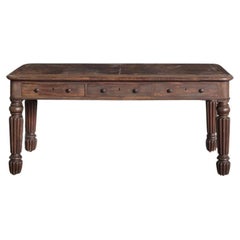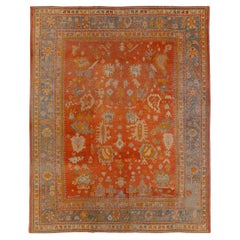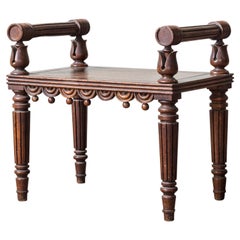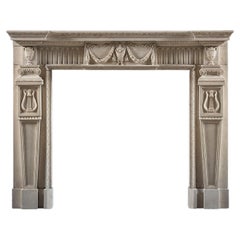Want more images or videos?
Request additional images or videos from the seller
1 of 6
A Late Nineteenth Century Writing Desk, In the Regency Manner
$86,376.40List Price
About the Item
- Dimensions:Height: 31.11 in (79 cm)Width: 54.34 in (138 cm)Depth: 35.83 in (91 cm)
- Style:Regency (In the Style Of)
- Materials and Techniques:
- Place of Origin:
- Period:
- Date of Manufacture:Late 19th Century
- Condition:Wear consistent with age and use.
- Seller Location:London, GB
- Reference Number:1stDibs: LU848141076302
About the Seller
No Reviews Yet
Vetted Professional Seller
Every seller passes strict standards for authenticity and reliability
Established in 2001
1stDibs seller since 2008
35 sales on 1stDibs
Typical response time: Several days
Authenticity Guarantee
In the unlikely event there’s an issue with an item’s authenticity, contact us within 1 year for a full refund. DetailsMoney-Back Guarantee
If your item is not as described, is damaged in transit, or does not arrive, contact us within 7 days for a full refund. Details24-Hour Cancellation
You have a 24-hour grace period in which to reconsider your purchase, with no questions asked.Vetted Professional Sellers
Our world-class sellers must adhere to strict standards for service and quality, maintaining the integrity of our listings.Price-Match Guarantee
If you find that a seller listed the same item for a lower price elsewhere, we’ll match it.Trusted Global Delivery
Our best-in-class carrier network provides specialized shipping options worldwide, including custom delivery.You May Also Like
Regency Mahogany Partners Writing Table In The Manner Of George Smith
By George Smith
Located in Benington, Herts
An Important Regency period mahogany, ebonised and parcel gilt partners writing table on monopodia legs of exceptional quality and design, in the manner of George Smith, stamped Chas...
Category
Antique Early 19th Century English Regency Desks and Writing Tables
Materials
Leather, Mahogany
$26,317
H 29.14 in W 64.57 in D 34.26 in
Walnut Writing Desk in the Manner of Gillows
Located in Cheshire, GB
Walnut writing desk almost certainly by Gillows, the large rectangular rounded top with inset tooled leather. To the freeze fitted with a pair of drawers on fluted turned columns and...
Category
Antique 19th Century British Desks and Writing Tables
Materials
Walnut
19th Century English Regency Walnut Writing Table in the Manner of Holland &Sons
By Holland & Sons
Located in Dublin, IE
A George IV walnut rectangular writing table, the top with inset leather scriver above a shaped frieze drawer, raised on pairs of turned side supports with lotus collars and stretche...
Category
Antique 19th Century English Regency Desks and Writing Tables
Materials
Walnut
$8,133
H 39.38 in W 30.32 in D 21.66 in
Late Regency Rosewood Writing Table
Located in Altrincham, GB
Late Regency Rosewood Writing Table with Mahogany Lined Drawer, Octagonal End Supports, and Blind Castors to the Bun Feet 56"w x 28"d x ...
Category
Antique 1820s English Regency Desks and Writing Tables
Materials
Rosewood
Late Regency Mahogany Writing Table
Located in Essex, MA
With a tooled olive green leather writing surface with wood border and molded edge over two drawers on front and back. Brass ring handles. Supported on turned tapered legs with casters.
Category
Antique 1820s English Regency Desks and Writing Tables
Materials
Brass
Pair of Gilt and Leather Pedestal Desks in the Regency Manner
Located in London, GB
Fine Pair of Antique Pedestal Desks in the Regency Manner
Constructed in goncalo alves, with gilt bronze mounts and giltwood highlights, of freestanding form, with very gentle inver...
Category
20th Century British Regency Desks
Materials
Bronze
$114,718 / set
H 32.5 in W 60 in D 35 in
Stunning Late 19th Century Desk in the Thomas Chippendale Manner
By Thomas Chippendale
Located in Dublin, IE
A stunning late 19th century mahogany desk in the Thomas Chippendale manner. The moulded top of rectangular form fitted with green gilt embossed tooled leather writing skiver surface...
Category
Antique Late 19th Century English Desks and Writing Tables
Materials
Brass
19th Century Regency brass inlaid writing desk
Located in Debenham, Suffolk
19th century regency brass inlaid writing desk circa 1925.
Beautifully made regency period writing table, profusely inlaid with brass stringing and decoration.
Rectangular flame ma...
Category
Antique Early 19th Century English Regency Desks and Writing Tables
Materials
Brass
Early 19th century Regency davenport writing desk
Located in Debenham, Suffolk
Fine quality Regency davenport, circa 1820.
Spindle gallery to the top leading to the original leather writing surface. Top opens to reveal a richly colored interior with 2 drawers....
Category
Antique Early 19th Century English Regency Desks and Writing Tables
Materials
Leather, Palisander
English Late Regency Oak Writing Table
Located in Queens, NY
English Late Regency (mid-19th Century) parcel ebonized & oak writing table with black leather inset top above X-trestle legs joined by a stretcher on casters.
Category
Antique 19th Century British Regency Desks and Writing Tables
Materials
Oak, Leather
More From This Seller
View AllA Late Regency Mahogany Writing Desk
Located in London, GB
With leather inset top and six drawers, on carved reeded legs with original inset brass casters. The boldly drawn leg of this table bears striking resemblance to the dining table sit...
Category
Antique Early 19th Century English Regency Tables
Materials
Brass
A Late Nineteenth Century Oushak Carpet (5774)
Located in London, GB
The muted gazpacho red field, with all over graphic medallion and flower head decoration, within blue and golden ochre border. The overall pile and surface quality in sparingly and a...
Category
Antique Late 19th Century Turkish Oushak Turkish Rugs
Materials
Wool, Cotton
Small Regency Oak Hall Bench, in the Manner of Bullock
By George Bullock
Located in London, GB
A Small Regency Oak Hall Bench, in the manner of Bullock
With turned bolster lotus leaf supports, above a panelled seat with a frieze of half r...
Category
Antique Early 19th Century British Regency Benches
Materials
Oak
A Nineteenth Century Limestone Chimneypiece in the Style of Inigo Jones
By Inigo Jones
Located in London, GB
The shelf carved with fine acanthus and egg & dart, above a prominent tablet carved with a central urn, flanked by draped wreaths hanging from bows. The urn is upheld by hoofs and be...
Category
Antique 19th Century English Regency Fireplaces and Mantels
Materials
Limestone
Gothic Revival Oak Writing Table by J. G. Crace, c.1850
Located in London, GB
A Gothic Revival Oak Writing Table by J. G. Crace, after a design by Pugin
With extensive gothic carving work, the sides with strapwork carving centred by a monogram reading “MP”, t...
Category
Antique 19th Century Gothic Revival Desks and Writing Tables
Materials
Oak
George III Mahogany and Red Leather Topped Writing Table
Located in London, GB
A George III Mahogany and Red Leather Topped Writing Table With adjustable ratcheting writing slope, three front drawers and brass handles, on straight mahogany legs. English, c.1760...
Category
Antique 18th Century George III Desks and Writing Tables
Materials
Mahogany
Recently Viewed
View AllMore Ways To Browse
Desk Beurdeley
Double Sided Partners Desk
Dunbar Roll Top Desk
Emile Jacques Ruhlmann Desk
Engineer Desk
English Architects Table
Escritoire Antique Writing Desk
Georgian Library Table
H P Hansen Desk
J R Griffin
King Louis Desk
L-Shaped Desks
Leather Top Gold Desk
Louis Xv Bureau A Cylindre
Maitland Smith Tessellated Desk
Mastercraft Brass Desk
Mcguire Desk
Mod Writing Desk



